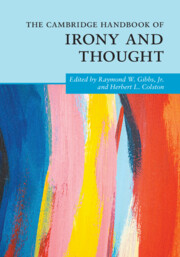Book contents
- The Cambridge Handbook of Irony and Thought
- Cambridge Handbooks in Psychology
- The Cambridge Handbook of Irony and Thought
- Copyright page
- Contents
- Contributors
- Part I Introduction
- Part II The Scope of Irony
- 2 Kinds of Irony: A General Theory
- 3 Irony and Cognitive Operations
- 4 The Varieties of Ironic Experience
- Part III Irony’s Impact
- Part IV Irony in Linguistic Communication
- Part V Irony, Affect, and Related Figures
- Part VI Irony in Expressive, Nonlinguistic Media
- Index
- References
2 - Kinds of Irony: A General Theory
from Part II - The Scope of Irony
Published online by Cambridge University Press: 20 December 2023
- The Cambridge Handbook of Irony and Thought
- Cambridge Handbooks in Psychology
- The Cambridge Handbook of Irony and Thought
- Copyright page
- Contents
- Contributors
- Part I Introduction
- Part II The Scope of Irony
- 2 Kinds of Irony: A General Theory
- 3 Irony and Cognitive Operations
- 4 The Varieties of Ironic Experience
- Part III Irony’s Impact
- Part IV Irony in Linguistic Communication
- Part V Irony, Affect, and Related Figures
- Part VI Irony in Expressive, Nonlinguistic Media
- Index
- References
Summary
This chapter offers a “conceptual geography” of the ways irony is expressed and understood through several representations of irony, as seen, for example, in fiction and film. Currie draws the careful distinction between cases where an event is represented as being ironic without the event itself being ironic (e.g., a film scene may be constructed to express irony without the scene itself necessarily being an example of situational irony). Dramatic irony, for example, often succeeds because of our knowing something that the characters do not. But the characters’ lack of knowledge is only a pointer to the irony and is not what actually constitutes the irony. Many so-called instance of verbal irony are “expressive,” but not really “communicative,” because they are expressive of an ironic state of mind without a speaker specifically aiming to communicate irony. Currie’s chapter dives into many of these complexities, which are too often ignored in theoretical discussions and explications of irony. His overarching aim is to raise our awareness about what should be counted as irony and what “should be abandoned as the product of an inflated vocabulary.”
- Type
- Chapter
- Information
- The Cambridge Handbook of Irony and Thought , pp. 17 - 37Publisher: Cambridge University PressPrint publication year: 2023



